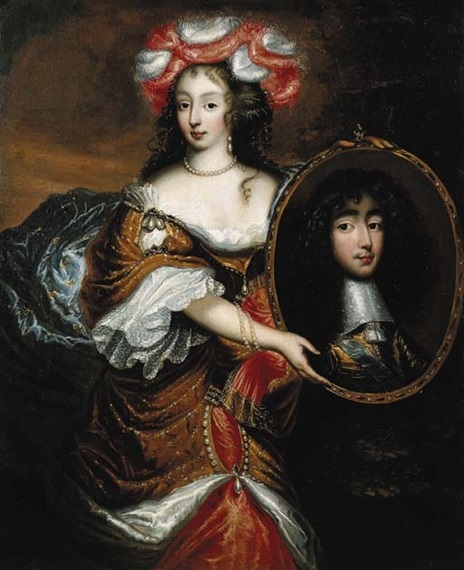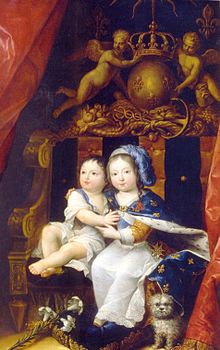Château de Saint-Cloud, Une Histoire.
There is a gem, just west of Paris, which once was a place as grand as Versailles, the Domaine National de Saint-Cloud. Close to the banks of the Seine, on an elevation with a magnificent view of Paris, stood a much admired château, surrounded by a large park, fabulous bosquets and fountains. The Russian Tsar Peter I was there in 1717, the American Founding Father Thomas Jefferson in 1786, the Algerian religious and military leader Emir Abdelkader in 1852, and Queen Victoria of Great Britain in 1855. A place that is not well-known today, but once was and witnessed so much.
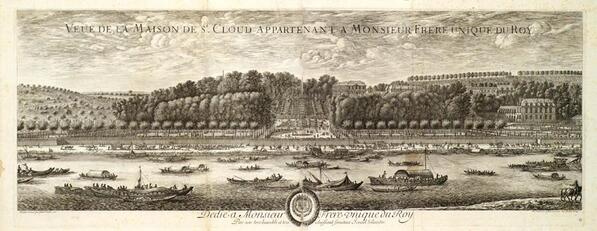
Known as the Hôtel d’Aulnay in the 1570’s , the estate belonged to the Gondis, a family of Florentine bankers, which came to France from Italy in the entourage of Catherine de’ Medici. The family settled in France and founded the French-branch of de Gondi, which swiftly rose to power and influence due to their wealth.
Before it was sold to Jérôme de Gondi, Catherine de’ Medici herself owned the estate and had it enlarged by the construction of a pavilion, which was enlarged again by adding two wings on each side of the Hôtel d’Aulnay. The main front faced south, with a wing that terminated in a pavilion affording a handsome view over the Seine river.
Henri III, the last Valois King of France, lodged with his army at the estate on the 1st of August 1574 preparing to attack Paris, after fleeing it in May the same year as Henri de Guise marched into Paris. It was a rather turbulent time for France with the Wars of Religion and the Catholic League grasping for power, and for Henri Saint Cloud was the perfect place to plan and oversee the attack on Paris, just on the other side of the Seine. A young fanatical Dominican friar named Jacques Clément, carrying false papers, was granted access to deliver important documents to Henri. He monk gave the King a bundle of papers and stated that he had a secret message to deliver. Henri thus signalled for his attendants to step back for privacy, and Clément whispered in his ear while plunging a knife into his abdomen. Clément was then killed on the spot by the guards. Henri died on the morning of the following day, the day that he had planned to launch his assault to retake Paris.
After the death of Jérôme de Gondi in 1604, the château, known as Maison de Gondi, was sold in 1618 by his son Jean-Baptiste II de Gondi to Jean de Bueil, Comte de Sancerre, who died shortly afterwards in 1625. The château was bought back then by Jean-François de Gondi, Archbishop of Paris, who enlarged the gardens.
As the Archbishop died, the estate was inherited by Philippe-Emmanuel de Gondi, who sold it to his nephew Henri de Gondi, Duc de Retz, before he in turn sold it to Barthélemy Hervat, a banker of German extraction who was Intendant then Surintendant des Finances, who enlarged the park to twelve hectares and did considerable rebuilding in the Italian style. Reports of the time describe an Italian style villa with an invisibly flat roof and frescoed facades, painted with colourful ornaments, as well as stucco reliefs of equestrian portraits of Charles IX., Henri III., Henri IV and Louis XIII., with view over the Seine and Paris. Its gardens descended in a series of terraces to the Seine, provided with fountains at each level and adorned by statues.
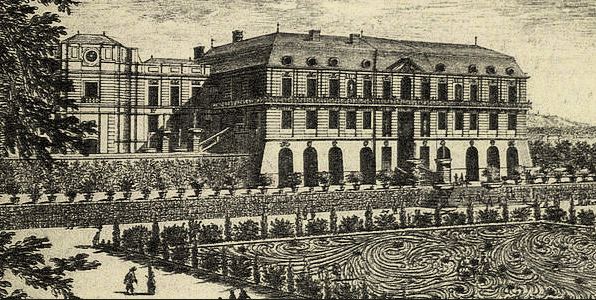
On 8 October 1658, Hervart organized a sumptuous feast at Saint-Cloud in honour of the young Louis XIV, his brother Philippe, Duc d’Orléans, their mother Anne d’Autriche and Cardinal Mazarin. A few days later the château was bought by the Cardinal for Philippe, an expensive present. While Hervart bought the château for 72000 livres, it was now sold to the Cardinal for approximately 331548 livres, due to the enlargements of the gardens and house. It appears that Mazarin pressed the sale, contributing to a policy of building a network of royal châteaux to the west of Paris, and relieving the excessively-enriched Hervart from the fate of Nicolas Fouquet, whose fête at Vaux-le-Vicomte precipitated his fall and imprisonment. Another reason for it was the need to give Philippe something to do, he was rather enamoured with the property and thus by having something for himself to occupy himself with, less likely to bother his big brother, the King.
Philippe had the gardens once more enlarged and remodeled several times, before he moved to alter the château itself after the death of his first wife Henriette d’Angleterre in the château. In 1671, after his wedding with Élisabeth Charlotte d’Orléans, the first measures were taken for the remodeling, while at the same time, just a few kilometres away, his brother Louis XIV enlarged the Chateau de Versailles.
A larger north wing was added to fit the proportions of the south wing, while the south wing was altered to match the new design of the north wing, a cour d’honneur created between them and a large basin was added just in front of the south wing. The Corps-de-Logis, the middle part of the château, was remodeled in 1677 with it being enlarged to the west and an extra floor being added. The facade was remodeled inspired by the style of Versailles and the Royal Residences, something actually just meant for the Royal Residences and the King. One can argue with what purpose this was done, surely to be able to receive the King in Saint Cloud in proper style, but perhaps, also a little to annoy him… Philippe was fond of showing the latest alterations off and create a certain degree of jealously in his brother, which also inspired him for certain alterations in Versailles.
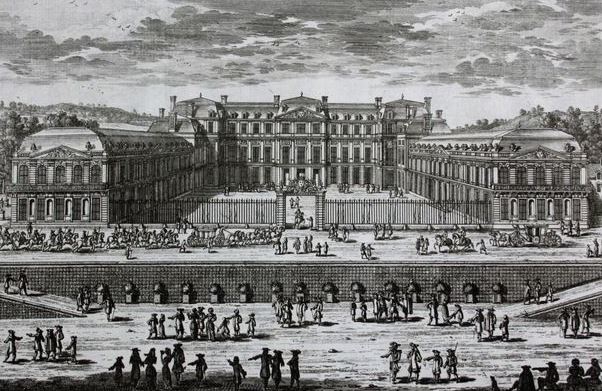
In 1680, the Galerie d’Apollon was finished. Located in the north wing and decorated with myths of Apollo by Pierre Mignard, it inspired Louis XIV to have his Hall of Mirrors built. The Galerie d’Apollon was a vast gallery taking up most of the north wing and connected the Salon de Mars with the Salon de Venus and the Chapel. In the Corps-de-Logis, several salons and state rooms were built, along with cabinets, it also hosted the apartment of Monsieur, while that of Madame was in the south wing.
The rooms in the Corps-de-Logis, among them a state apartment for Louis XIV, should he visit, were all centered around the Chambre du Roi. This was first practised in Saint Cloud and later adopted by Louis XIV for Versailles, with the King’s bedroom being at the very center of the château.
The first building campaign at Saint Cloud, lead by the architects Antoine Le Pautre, Jean Girard and Thomas Gobert, was finished in 1678 and had turned the château into a place that deserved the name. The rooms richly furnished, ceilings painted by the great Pierre Mignard, statues of the whitest marble, curtains of the best fabrics, gold and silver plated doors, grand chandeliers hanging from thick velvet strings, the floors polished and tapestries worth a fortune. Vast galleries and salons filled with the scents of flowers and blooming orange trees wafting in from the garden, with its fountains and endless allies, grottos and bosquests, everything overlooking Paris in the distance. A smaller and less uptight Versailles.
Jules-Hardouin Mansart, whose work is generally considered to be the apex of French Baroque architecture, oversaw the second building campaign starting in 1687. A orangery was added at the west side of the Corps-de-Logis along a Salle de Théâtre and the south wing, Aile Gauche, was once more altered by adding a grand staircase, in the manner of the Ambassadors’ Staircase at Versailles. This open stair case connected the garden with the first floor of the south wing, the apartments and the cour d’honneur. To match the design of the new stair case, the ceiling of the south wing was altered and a pavilion created at its center, with columns were added to garden the facade and a large balcony. André Le Nôtre designed the gardens and enlarged the basin at the south wing, to what is known as the Bassin du Fer à Cheval. A fountain with five small cascades with a path around it in form of a ramp in horseshoe design, that connected Mansart’s new stair case with the garden.

One of Saint Cloud’s highlight is the Grande Cascade built by Antoine Le Pautre, Monsieur’s appointed house architect, between 1664 and 1665. It faces Paris on the Seine side of the garden and is one of the most remarkable feats of hydraulic engineering of the 17th century. Louis XIV was certainly jealous of that one.
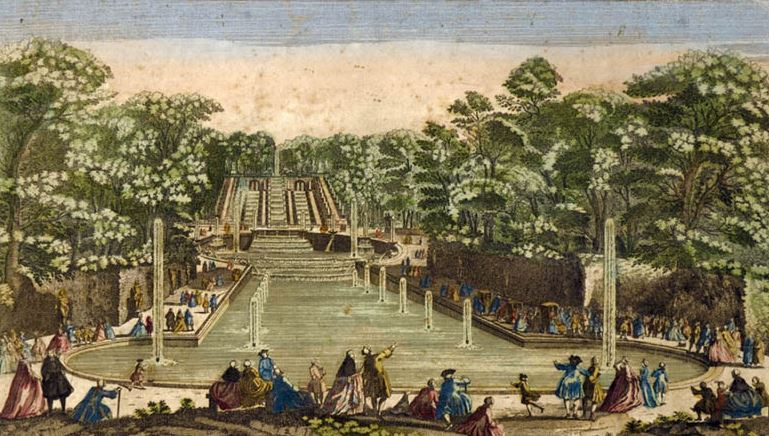
As Philippe died at the château in 1701, itremained property of the Mansion d’Orléans and little to no alterations were performed, but the château frequently visited by Louis XIV., Louis XV. and Louis XVI, mostly for hunts. After protracted negotiations, the château de Saint-Cloud was bought in 1785 by Louis XVI for Marie-Antoinette, who was convinced that the air of Saint-Cloud would be good for her children. After the sale of the palace was officially finished, Marie Antoinette set about transforming her new private home. She set to transforming Saint-Cloud in 1787-1788 by her preferred architect Richard Mique, who enlarged the corps de logis and the adjacent half of the right wing; he rebuilt the garden front. Hardouin-Mansart’s masterpiece of a staircase was demolished, just like the Ambassadors’ Staircase in Versailles was demolished, in favour of a new stone stairs giving onto the state apartments.
The château was at first refurbished from the Garde Meuble with furnishing collected from other royal residences, but soon furniture was commissioned for Saint-Cloud. Gilded chairs and marquetry commodes with gilt-bronze mounts in the richest Louis XVI taste were being delivered to Saint-Cloud right to the opening days of the French Revolution. In 1790, Saint-Cloud was the setting for the famous interview between Marie Antoinette and Mirabeau and later declared bien national, national property. Its salons and galleries were emptied and everything that could be sold, was sold.
A few years later, on 10 November 1799, the orangery of the château was the very place were the Directory, the government of France during the penultimate stage of the French Revolution, retreated to after being warned of a Jacobin conspiracy.
A certain General Napoleon was in charge of their safety… and overthrew them in a coup d’état, becoming the First Consul of France and in the view of most historians, ending the French Revolution. Five years later, on May 18 in 1804, he was proclaimed Eemperor in Saint Cloud.
Napoleon made Saint-Cloud his preferred residence and transformed the Salon de Vénus to a throne room, which Saint-Cloud had naturally lacked, but neither he nor the occupants to follow did much more to Saint-Cloud than works of interior decoration.
It was at Saint-Cloud once again, in Monsieur’s Galerie d’Apollon, that Napoléon III invested himself as Emperor of the French on 1 December 1852. During the Second Empire, Napoléon III and Empress Eugénie held court at Saint-Cloud in the spring and the autumn. Napoléon III had the orangery demolished in 1862, and Eugénie transformed the bedroom of Madame into a salon in Louis XVI style.
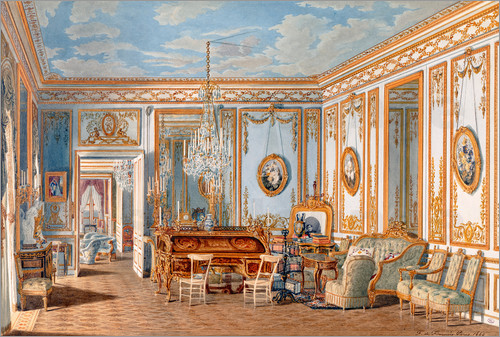
A listing of 1864 describes the dimension of the château: The park covers 392 hectares. The palace and the outbuildings house, next to the apartments of the Emperor and Empress, 45 apartments de Maître, 600 suites, stables for 232 horses, a shed for 20 carriages, a private guards consisting of 180 men of infantry and 34 cavalry. Also respective barracks for the Gardes du Corps, which once again host 1500 infantrymen and 150 cavalrymen.
Napoléon III declared war on Prussia on 28 July 1870, in Saint Cloud and the château was destroyed half a year later. The heights dominating Paris were occupied by the Prussians during the siege of Paris, who shelled Paris from the grounds of the château. Counter-fire from the French hit the building, and it caught fire on 13 October 1870. Attempts to put out the flames were not possible, due to the continuing fighting, and so the château burned down to its walls.

The standing roofless walls were razed in 1891. The pediment of the château’s right wing, one of the preserved parts of the building, was bought by Ferdinand I of Bulgaria and integrated in his palace Euxinograd on the Black Sea coast.
Today, only a few outbuildings and its park of 460 hectares remains, one of the most beautiful gardens in Europe, constituting the Domaine national de Saint-Cloud. It includes the garden à la française designed by Le Nôtre, Marie-Antoinette’s flower garden,where roses for the French state are grown, a garden à l’anglaise from the 1820s called the Trocadéro garden, ten fountains, and a viewpoint of Paris known as “la lanterne”, named after the lantern which was lit there when Emperor Napoléon I was in residence at Saint Cloud.
Since 2003 the park is the venue for the Rock en Seine festival and in 2006 the association “Reconstruisons Saint-Cloud!” was created, aiming to found the rebuilding of the château. The park today hosts the Musée du château de Saint-Cloud,a five-room museum dedicated to the destroyed château, the École Normale Supérieure in the Pavillon Valois, and the Bureau International des Poids et Mesures, Pavillon de Breteuil, build by Gobert for Monsieur in 1672… last but not least, the video of Sinéad O’connor’s Nothing Compares 2U was filmed in the park of Saint Cloud.
If I woke your interest, check out my pinterest for more pictures and stay tuned for much ado about my visit to Saint Cloud.



